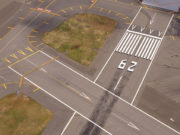One-third of the pilots questioned in an Australian Transport Safety Bureau (ATSB) survey say they told managers at least once in the 12 months before responding to the 2016 survey that they were too fatigued to fly — and that they believed their fatigue reports were frowned upon by management, the ATSB says.1
In its report, Fatigue Experiences and Culture in Australian Commercial Air Transport Pilots, the ATSB said that, despite the pilots’ concerns, most responded that they were well rested at the end of their last duty periods.
In a report on another fatigue-related subject, researchers from Embry-Riddle Aeronautical University (ERAU) and Hampton University found that 70 percent of pilots participating in a small survey said they either approved or strongly approved of changing U.S. policy to allow the use of controlled rest in position (CRIP) in which a pilot is permitted to take a short, scheduled nap on the flight deck to help combat fatigue.2
In introducing the ATSB report, Chief Commissioner Greg Hood said, “The responsibility to manage the risk of fatigue lies with both pilots and operators. Pilots need to use rest periods to get adequate sleep and remove themselves from duty if affected by fatigue, and operators need to have policies in place to manage fatigue and create a work culture [where] pilots and crew can report fatigue in a supportive environment.”
The study was based on an online survey that examined fatigue and other issues, including safety culture. Emails were sent to chief pilots and safety officers of passenger, freight and aeromedical operators to ask them to distribute the survey link to their pilots, and the survey was promoted on the ATSB website and the agency’s Facebook.
The report said 625 people responded, with the largest number of them (230) involved in short-haul domestic jet operations. Long-haul international pilots made up the second-largest group of 133, followed by pilots for charter operators (100), regional turboprop and piston regular public transport operators (86), aeromedical operators (66) and non-aeromedical helicopter operators (10).
The report conceded that the number of survey participants was relatively small but that the category-by-category breakdowns “broadly correspond to the number of licence holders per type.”
Although the majority of those surveyed said that they were well rested at the end of their most recent duty period, 11 percent said that they had been awake for at least 19 hours, including 4 percent who said they had been awake for 22 hours or longer. Those hours are “thresholds associated with impairments in performance,” the report said, citing earlier research. Long-haul pilots reported the longest stretches awake, with about half saying that they had been awake for 16 hours or longer.
Rating themselves on a seven-point scale ranging from 1 for “fully alert, wide awake, extremely peppy” to 7 for “completely exhausted, unable to function effectively, ready to drop,” about one-quarter of the pilots believed that they were “sufficiently alert” when their duty time ended. Nearly half said that they were moderately to severely fatigued, including half of short-haul pilots and 60 percent of long-haul pilots (Figure 1).
Figure 1 — Self-Rated Alertness at the Eend of Last Flight by Operation Type
Source: Australian Transport Safety Bureau
“For short-haul operations, results indicate the more sectors flown in a month, the more pilots reported feeling tired,” the report said. “Pilots who undertake many sectors will have many takeoffs and landings, both high workload phases of flight … which can increase feelings of fatigue.”
Hood said that the survey found “a small but significant number of pilots, 10 percent and 17 percent, who reported obtaining less than five hours of sleep in the previous 24 hours or less than 12 hours in the previous 48 hours, respectively, at the end of their last flight. These sleep thresholds have been shown to be associated with impaired performance.”
International and domestic jet airline pilots were more likely than regional, charter and aeromedical pilots to have obtained less sleep while on duty than during their time at home, the report said. One-third of respondents said they obtained the same amount of sleep at home as they did while on duty, about half said they obtained less sleep while on duty, and 15 percent of international pilots said they had no rest during their last international flight.
Leaving An Impression
In responding to questions about the instances during the previous 12 months when they removed themselves from duty because of fatigue, 22 percent said they felt “mostly comfortable” and 20 percent said they were “always comfortable” taking that action, while 31 percent said they were “rarely comfortable” about doing so; 13.6 percent said that they would not be comfortable removing themselves from duty because of fatigue and that they “would always choose to fly” (Figure 2).
Figure 2 — Overall Responses to Feeling Comfortable Removing Self from Duty Due to Fatigue
Source: Australian Transport Safety Bureau
Captains of multi-crew and single-pilot operations were more likely than first officers to respond that they were “mostly” or “always” comfortable declining to fly when they were fatigued — about 47 percent of captains reported that reaction compared with 34 percent of first officers (Figure 3).
Figure 3 — Comfortable Removing Self from Duty Due to Fatigue in the Past 12 Months by Role
Source: Australian Transport Safety Bureau
More than half of survey respondents said that they never used their company’s process for removing themselves from duty because of fatigue while one-third said that they had. Some 7.5 percent said “this was not an option” in their company, the report said.
Overall, about one-quarter of long-haul and regional pilots and one-third of short-haul and aeromedical pilots had removed themselves from duty because of fatigue for from one to three days during the previous 12 months, the report said.
Of the 277 pilots who said fatigue had kept them off duty, 57 percent believed that their action “left a negative impression with management,” the report said (Figure 4). Aeromedical pilots, however, were more likely to believe that management had a positive impression when they cited fatigue in removing themselves from duty.
Figure 4 — Impression Left With Management When Time was Taken for Fatigue in the Past 12 Months by Operation Type
Source: Australian Transport Safety Bureau
“Reasons for these perspectives could be examined in future research,” the report said.
New Rules
The Australian Civil Aviation Safety Authority currently is consulting with industry representatives on the introduction of new fatigue rules in accordance with Civil Aviation Order 48.1, Instrument 2019, Modernising Australia’s Fatigue Rules.
High capacity regular public transport operations are required to transition to the new rules by Sept. 30; other operators face a March 26, 2020, deadline.
CASA’s update of the rules follows a March 2018 independent review that called for revising flight and duty time limitations so that they more closely align with international averages. The review found that some of the existing rules are “expressed in an overly prescriptive tone.”
Opinions on Controlled Rest
The 30-pilot ERAU study consisted of an online survey that asked participants to characterize their opinions of the prospect that CRIP might be introduced in the U.S. commercial fleet, where it is currently prohibited. The practice is permitted in a number of other countries, including Canada, as well as by U.S. military pilots.
A paper published in 2018 by the Fatigue Countermeasures Working Group — comprised of fatigue safety managers from commercial air carriers, representatives of pilot unions and sleep scientists — concluded that a correctly designed and monitored CRIP program could reduce fatigue-related safety risk and could be an effective tool for use by pilots in managing their fatigue (“Controlled Rest,” ASW, 11/18).
In response to the survey question of “how strongly do you disapprove or approve of using CRIP in the United States?” 70 percent of respondents said that they would “approve” or “strongly approve,” while 16 percent said they would disapprove; 14 percent said they would neither disapprove nor approve.
“Participants, on average, felt one to two naps should be completed per four-hour block, with the length of each nap just less than 45 minutes,” the report said. “Participants indicted that they felt the napping pilot should be awake for just over 15 minutes to get over sleep inertia3 before re-engaging in flight responsibilities (assuming a non-emergency scenario).”
Survey participants cited numerous benefits of CRIP, including that short, controlled naps would ease fatigue for three to four hours and improve crew alertness. “It’s much better to nap than nod,” one participant commented.
The report said that some pilots saw possible weaknesses in allowing CRIP, including a fear that airlines might take advantage of pilots and use controlled napping as “a patch for … failed scheduling and crew pairing,” and a concern that some pilots would “scoff at or not allow CRIP on their flight.”
Another concern was the ability of the non-resting pilot to remain awake while the second pilot slept, the report said, adding that “several participants were concerned that implementing CRIP could more easily result in both pilots falling asleep.”
Other respondents worried about a negative reaction from the U.S. public. “Would American passengers be willing to fly in an airplane when they know the pilots are allowed to sleep during cruise?” one pilot wondered.
Asked for recommendations about the use of CRIP, respondents said that CRIP should be used “as a fatigue management tool, not a substitution for crew rest,” that non-cockpit crewmembers should check frequently on the pilots and that data should be collected and analyzed to ensure that CRIP is being implemented properly and that it is effective.
Notes
- ATSB. Transport Safety Report AR-2015-095, Fatigue Experiences and Culture in Australian Commercial Air Transport Pilots. Canberra, Australian Capital Territory, Australia, 2019.
- Rice, Stephen; Winter, Scott R.; Anania, Emily C.; Tamilselvan, Gajapriya; Doherty, Shawn. “Commercial Airline Pilots’ Attitudinal Data on Controlled Rest in Position: A Qualitative Inquiry.” Collegiate Aviation Review International Volume 36 (2): 71–91.
- Sleep inertia is the period of grogginess or impaired alertness that occurs immediately after waking.
Featured image: © lvcandy | iStockphoto

